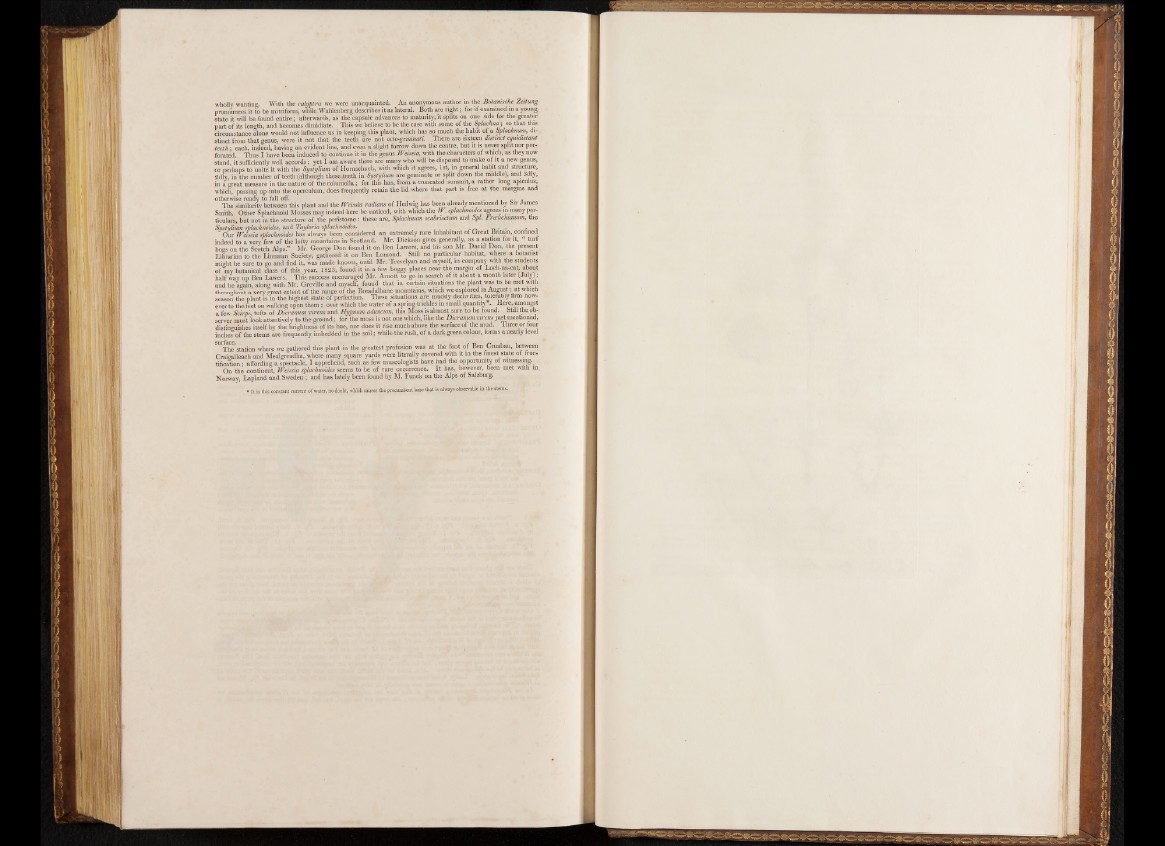
wholly wanting. With the calyptra we were unacquainted. An anonymous author in the Botanisclie Zeitung
pronounces it to be mitriform, while Wahlenberg describes it as lateral. Both are right; for if examined in a young
state it will be found entire; afterwards, as the capsule advances to maturity, it splits on one side for the greater
part of its length, and becomes dimidiate. This we believe to be the case with some of the Splachna; so that this
circumstance alone would not influence us in keeping this plant, which has so much the habit o f a Splachnum, distinct
from that genus, were it not that the teeth are not octo-geminati. There are sixteen distinct equidistant
teeth; each, indeed, having an evident line, and even a slight furrow down the centre, but it is never split nor perforated.
Thus I have been induced to continue it in the genus Weissia, with the characters o f which, as they now
stand, it sufficiently well accords; yet I am aware there are many who will be disposed to make of it a new genus,
or perhaps to unite it with the Systylium o f Hornschuch, with which it agrees, 1 st, m general habit and structure,
2dly, in the number of teeth (although these teeth in Systylium are geminate or split down the middle), and 3dly,
in a great measure in the nature of the columella; for this has, from a truncated summit, a rather long apiculus,
which, passing up into the operculum, does frequently retain the lid where that part is free at the margins and
otherwise ready to fell off. , T
The similarity between this plant and the Weissia radians of Hedwig has been already mentioned by Sir James
Smith. Other Splachnoid Mosses may indeed here be noticed, with which the W. splachnoides agrees in many particulars,
but not in the structure o f the peristome: these are, Splachnum scabrisetum and Spl. Fralichtanum, the
Systylium splachnoides, and Tayloria splachmides. . . . . . . „ e r * * ti ^ c .
Our Weissia splachnoides has always been considered an extremely rare inhabitant of Great Britain, confined
indeed to a very few o f the lofty mountains in Scotland. Mr. Dickson gives generally, as a station tor it, turt
bogs on the Scotch Alps.” Mr. George Don found it on Ben Lawers, and his son Mr. David Don, the present
Librarian to the Linnasan Society, gathered it on Ben Lomond. Still no particular habitat, where a botanist
might be sure to go and find it, was made known, until Mr. Trevelyan and myself, m company with the students
of my botanical class of this year, 1823, found it in a few boggy places near the margin of Loch-na-cat, about
half way up Ben Lawers. This success encouraged Mr. Arnott to go in search of it about a month later (July);
and he again, along with Mr. Greville and myself, found that in certain situations the plant was to be met with
throughout a very great extent of the range of the Breadalbane mountains, which we explored in August; at which
season the plant is in the highest state of perfection. These situations are muddy declivities, tolerably hrm however
to the feet on walking upon them; over which the water of a spring trickles in small quantity . Here, amongst
a few ScirpL tufts of Dicranum virens and Hypnum aduncum, this Moss is almost sure to be found, still the observer
must look attentively to the ground; for the moss is not one which, like the Dicranum virens just mentioned,
distinguishes itself by the brightness of its hue, nor does it rise much above the surface of the mud. lhree or tour
inchef of the stems are frequently imbedded in the soil; while the rush, of a dark green colour, forms a nearly level
SU The station where we gathered this plant in the greatest profusion was at the foot of Ben Cruaban, between
Craigalleach and Mealgreadha, where many square yards were literally covered with it m the finest state of fructification;
affording a spectacle, I apprehend, such as few museologists have had the opportunity of witnessing.
On the continent, Weissia splachnoides seems to be of rare occurrence. It has, however, been met with in ,
Norway, Lapland and Sweden; and has lately been found by M. Funck on the Alps of Salzburg.
* It is this constant current of w 10 doubt, winch causes the procumbent base that is always observable in the stems.